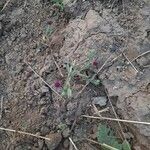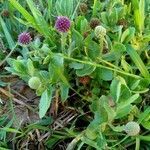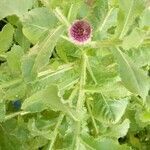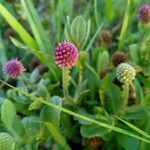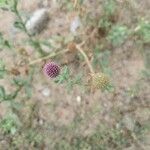Plants rank-smelling. Stems 10-45 cm tall with 4 irregularly and sharply toothed wings, minutely stipitate glandular and whitish pubescent. Leaves oblanceolate or spatulate, 2.5-6 × 0.8-2.5 cm, minutely stipitate glandular and white lanate on both surfaces, base semiamplexicaul and strongly decurrent, margin rather irregularly biserrate-dentate, apex obtuse or acute, apiculate, attenuate. Clusters of capitula ovoid-globose, ca. 12 × 10 mm; capitulum bracts linear-lanceolate, 4-5 mm, ciliate, hispid and stipitate glandular, apex finely acuminate. Phyllaries ca. 12, linear-oblong to linear-spatulate, more scarious and less glandular than bracts. Marginal florets 10-15; central florets 2 or 3; corollas purplish, ca. 2.4 mm. Achenes ca. 1 mm, puberulent. Fl. Dec-Apr. 2n = 20.
An annual herb. It grows erect and has an aroma. It has 4 irregular and sharply toothed wings. It grows 50 cm high. The leaves are long sword shaped or spoon shaped and 3-6 cm long by 1-3 cm wide. There are irregular double teeth along the edge. The flowers are purple, pink and white.
